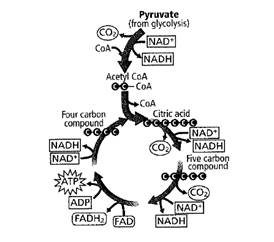
Concept explainers
To identify and summarize:
The steps of the cycle in the given figure
Introduction:
Organisms obtain energy through a process called
Answer to Problem 18STP
The cycle in the given figure is of Krebs cycle. The steps of the cycle can be summarized as follows:
- AcetylCoA combines with a 4- carbon compound to form a 6- carbon compound known as citric acid.
- Citric acid is then broken down in a series of steps releasing carbon dioxide and generates one ATP, 3 NADH and 1 FADH2.
- Finally acetyl CoA and citric acid are regenerated and the cycle continues.
Explanation of Solution
The following figure is given:

The end products of glycolysis are two ATP molecules and two pyruvate molecules. Most of the energy from the glucose is still present in pyruvate. In the presence of oxygen, pyruvate is transported into the mitochondrial matrix, where it is finally converted to carbon dioxide. The series of reactions involved in breaking down pyruvate to carbon dioxide is called Krebs cycle or tricarboxylic acid (TCA) cycle. It is also called citric acid cycle.
Just before Krebs cycle starts, pyruvate reacts with coenzyme CoA to form a two carbon intermediate called acetyl CoA. Carbondioxide is released and NAD+ is converted to NADH. AcetylCoA then moves to mitochondrial matrix. The reaction produces two CO2 molecules and two NADH.
The Krebs cycle starts with acetyl CoA combining with a 4- carbon compound to form a 6- carbon compound known as citric acid. Citric acid then breaks down in a series of steps releasing carbon dioxide and generating one ATP, 3 NADH and 1 FADH2. FAD and NAD+ are electron carriers.
Finally acetyl CoA and citric acid are regenerated and the cycle continues. Two turns of Krebs cycle occurs for one glucose molecule. The net yield of Krebs cycle is 6CO2 molecules, 2 ATP, 8NADH and 2FADH2.
Chapter 11 Solutions
Biology Illinois Edition (Glencoe Science)
Additional Science Textbook Solutions
Campbell Biology in Focus (2nd Edition)
Concepts of Genetics (12th Edition)
Cosmic Perspective Fundamentals
Human Anatomy & Physiology (2nd Edition)
Human Physiology: An Integrated Approach (8th Edition)
Laboratory Experiments in Microbiology (12th Edition) (What's New in Microbiology)
- students in a science class investiged the conditions under which corn seeds would germinate most successfully. BAsed on the results which of these factors appears most important for successful corn seed germination.arrow_forwardI want to write the given physician orders in the kardex formarrow_forwardAmino Acid Coclow TABle 3' Gly Phe Leu (G) (F) (L) 3- Val (V) Arg (R) Ser (S) Ala (A) Lys (K) CAG G Glu Asp (E) (D) Ser (S) CCCAGUCAGUCAGUCAG 0204 C U A G C Asn (N) G 4 A AGU C GU (5) AC C UGA A G5 C CUGACUGACUGACUGAC Thr (T) Met (M) lle £€ (1) U 4 G Tyr Σε (Y) U Cys (C) C A G Trp (W) 3' U C A Leu בוט His Pro (P) ££ (H) Gin (Q) Arg 흐름 (R) (L) Start Stop 8. Transcription and Translation Practice: (Video 10-1 and 10-2) A. Below is the sense strand of a DNA gene. Using the sense strand, create the antisense DNA strand and label the 5' and 3' ends. B. Use the antisense strand that you create in part A as a template to create the mRNA transcript of the gene and label the 5' and 3' ends. C. Translate the mRNA you produced in part B into the polypeptide sequence making sure to follow all the rules of translation. 5'-AGCATGACTAATAGTTGTTGAGCTGTC-3' (sense strand) 4arrow_forward
- What is the structure and function of Eukaryotic cells, including their organelles? How are Eukaryotic cells different than Prokaryotic cells, in terms of evolution which form of the cell might have came first? How do Eukaryotic cells become malignant (cancerous)?arrow_forwardWhat are the roles of DNA and proteins inside of the cell? What are the building blocks or molecular components of the DNA and proteins? How are proteins produced within the cell? What connection is there between DNA, proteins, and the cell cycle? What is the relationship between DNA, proteins, and Cancer?arrow_forwardWhy cells go through various types of cell division and how eukaryotic cells control cell growth through the cell cycle control system?arrow_forward
 Human Anatomy & Physiology (11th Edition)BiologyISBN:9780134580999Author:Elaine N. Marieb, Katja N. HoehnPublisher:PEARSON
Human Anatomy & Physiology (11th Edition)BiologyISBN:9780134580999Author:Elaine N. Marieb, Katja N. HoehnPublisher:PEARSON Biology 2eBiologyISBN:9781947172517Author:Matthew Douglas, Jung Choi, Mary Ann ClarkPublisher:OpenStax
Biology 2eBiologyISBN:9781947172517Author:Matthew Douglas, Jung Choi, Mary Ann ClarkPublisher:OpenStax Anatomy & PhysiologyBiologyISBN:9781259398629Author:McKinley, Michael P., O'loughlin, Valerie Dean, Bidle, Theresa StouterPublisher:Mcgraw Hill Education,
Anatomy & PhysiologyBiologyISBN:9781259398629Author:McKinley, Michael P., O'loughlin, Valerie Dean, Bidle, Theresa StouterPublisher:Mcgraw Hill Education, Molecular Biology of the Cell (Sixth Edition)BiologyISBN:9780815344322Author:Bruce Alberts, Alexander D. Johnson, Julian Lewis, David Morgan, Martin Raff, Keith Roberts, Peter WalterPublisher:W. W. Norton & Company
Molecular Biology of the Cell (Sixth Edition)BiologyISBN:9780815344322Author:Bruce Alberts, Alexander D. Johnson, Julian Lewis, David Morgan, Martin Raff, Keith Roberts, Peter WalterPublisher:W. W. Norton & Company Laboratory Manual For Human Anatomy & PhysiologyBiologyISBN:9781260159363Author:Martin, Terry R., Prentice-craver, CynthiaPublisher:McGraw-Hill Publishing Co.
Laboratory Manual For Human Anatomy & PhysiologyBiologyISBN:9781260159363Author:Martin, Terry R., Prentice-craver, CynthiaPublisher:McGraw-Hill Publishing Co. Inquiry Into Life (16th Edition)BiologyISBN:9781260231700Author:Sylvia S. Mader, Michael WindelspechtPublisher:McGraw Hill Education
Inquiry Into Life (16th Edition)BiologyISBN:9781260231700Author:Sylvia S. Mader, Michael WindelspechtPublisher:McGraw Hill Education





